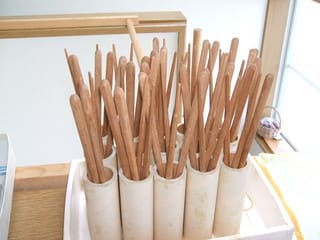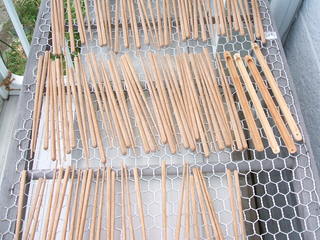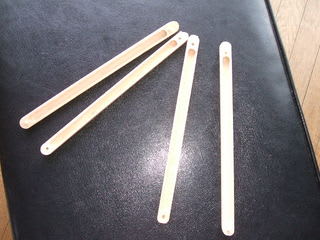This morning, I was late in getting up. It was 10:30...
And, I had to tak my wife to Kamakura, one way..., at
11:15!
So, the first thing I did on return was to retrieve the
result of yesterday's coating. You see them bellow.


In each of the tubes, two pairs of chopstics are stored
in antiparalell, for identification. Their surfaces are
very rough and the roughness must be removed by wet sanding.
Bellow, you see a very clear water before wet sanding.

Can you see how murky the water has become?

You then have to dry them for a substantial length of time, as shown
bellow...

In terms of today's output what is shown bellow is all I did,
apart from the second coating...

Only two containers! There are things, though, you learn from time to time... Today, I meant to complete 4 containers. By the time I have finished with the two I moved on to today's second coating.
Why?, because, you do not want to spend time on coating
in the windowless coating house when the heat is most intense...

Above illustration shows where I am going with respect to
banging together of the containers. One of the holes, at least,
must be elongated, as shown in B.
This is because the two halves must come apart easily and
I can see two arrangements, which spring to my mind.
One is to make the peg protrusion as law as possible and the
other is to elongate one of the holes, as shown in B.
Easy to talk about hole elongation, and normally what you
need is an endmill of the diameter you want. Unfortunately, I do not happen to have the diameter I need...
Ordinary drill bits do not cut sideways. They only makes holes...
However, if you fix the containers with the vice firmly, it
does not matter.
Naturally, you cannot do this operation with your bench
drill, as the drill bit will wonder around. So much easier
to do this with your milling machine, even without an
approapriate endmill!



And, I had to tak my wife to Kamakura, one way..., at
11:15!
So, the first thing I did on return was to retrieve the
result of yesterday's coating. You see them bellow.


In each of the tubes, two pairs of chopstics are stored
in antiparalell, for identification. Their surfaces are
very rough and the roughness must be removed by wet sanding.
Bellow, you see a very clear water before wet sanding.

Can you see how murky the water has become?

You then have to dry them for a substantial length of time, as shown
bellow...

In terms of today's output what is shown bellow is all I did,
apart from the second coating...

Only two containers! There are things, though, you learn from time to time... Today, I meant to complete 4 containers. By the time I have finished with the two I moved on to today's second coating.
Why?, because, you do not want to spend time on coating
in the windowless coating house when the heat is most intense...

Above illustration shows where I am going with respect to
banging together of the containers. One of the holes, at least,
must be elongated, as shown in B.
This is because the two halves must come apart easily and
I can see two arrangements, which spring to my mind.
One is to make the peg protrusion as law as possible and the
other is to elongate one of the holes, as shown in B.
Easy to talk about hole elongation, and normally what you
need is an endmill of the diameter you want. Unfortunately, I do not happen to have the diameter I need...
Ordinary drill bits do not cut sideways. They only makes holes...
However, if you fix the containers with the vice firmly, it
does not matter.
Naturally, you cannot do this operation with your bench
drill, as the drill bit will wonder around. So much easier
to do this with your milling machine, even without an
approapriate endmill!













